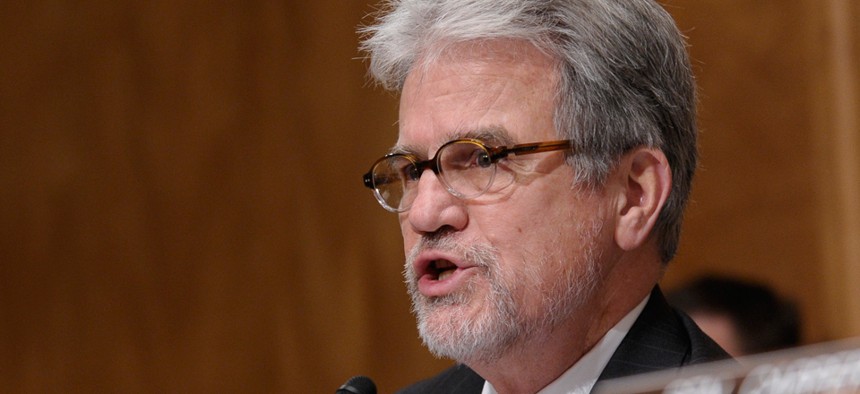
“It will allow us to address the $200 billion in duplication in programs identified by the Government Accountability Office," Sen. Tom Coburn, R-Okla., said. Susan Walsh/AP
Good-Government Gurus Embrace, Expand on Obama Management Agenda
Ex-OMB performance leader questions GOP plan for inventory of federal programs.
President Obama’s recently revitalized second-term management agenda earned a thumbs-up from a quartet of private and nonprofit reform advocates during a congressional hearing on Monday, though the good government experts had plenty of additional suggestions, ranging from focusing agencies on a few major problems to revamping the federal hiring process.
Senate Homeland Security and Governmental Affairs Committee ranking member Sen. Tom Coburn, R-Okla., framed Monday’s discussion of performance-based management items in Obama’s fiscal 2015 budget around the Taxpayers Right to Know Act. The Republican-backed bill to require an inventory of federal programs passed the House in February and has 37 senator co-sponsors, Coburn noted. “It will allow us to address the $200 billion in duplication in programs identified by the Government Accountability Office, to give us a basic stat sheet for every agency so we know what we’re doing and what’s the plan.”
But Shelley Metzenbaum, former associate director for performance and personnel management at the Office of Management and Budget and now president of the nonprofit Volcker Alliance, cautioned that “before adding new data requirements, we should ask what question we are trying to answer.” The bill is worthy of consideration, she said, but she added she “fears it could exacerbate silos. If we make programs the primary unit of reporting, people will protect their turf. Are we talking about clean water or clean water in Delaware? Rulemaking or inspections? You really want it to be about clean water.”
Instead, Metzenbaum recommended that Congress and the administration together “shine a spotlight on a few mission areas and find out what is working and what is not.”
Overall, the past three administrations have made “noteworthy progress” on management, she said, but “too few agencies are using goals for refining priorities. We need to spend more time implementing -- using performance data to find ways to improve, to use goals to communicate priorities, rather than just completing reports.”
The government also needs to consult the state “laboratories of democracy” and find ways to more quickly tap private-sector expertise, she said. The federal hiring process, Metzenbaum added, “is seriously limited, [and] the intern process, just plain broken.”
Max Stier, president and CEO of the nonprofit Partnership for Public Service --which on Wednesday is unveiling a proposal for comprehensive civil service reform -- also stressed problems in hiring. Only 7 percent of federal employees are under age 30, compared with 23 percent in the private sector, he said. “We’re not diverse, and we’re not taking the best talent out of our universities.”
Among eight specific reform proposals, Stier suggested allowing agencies to work together on recruiting talent, noting that current rules prohibit, for example, the Homeland Security Department from interviewing 10 qualified cyber-security employees, hiring five and then sending the other five to another agency. “Instead the other agency has to start over,” he said.
Overall, Stier said, there’s not enough focus on management issues. “You won’t see change in agencies without long-term leadership being held accountable,” he said. Senior executives should be accountable for engaging their employees to improve morale, an approach put in place successfully at the Transportation Department by since-retired Secretary Ray LaHood, Stier said.
Other reforms should include “treating government as a single enterprise,” which means allowing more sharing of services and employees, such as detailing congressional staff to agencies, he said. He also recommended that Congress hold hearings on improving presidential transitions, reducing the number of federal jobs requiring Senate confirmation, and reforming compensation so that the government isn’t “paying a physicist the same as a physical therapist.”
Robert Shea, a principal at Grant Thorton LLP, detailed his work on management reforms such as agency “scorecards” at OMB during the George W. Bush administration. “Agencies made real progress during this period,” he said, “and today we have a new opportunity. But without clear metrics to gauge program performance, it will be difficult to tell what we actually achieve. We know far too little about which programs work best.”
Shea recommended focusing on programs GAO has identified as duplicative or high-risk. “If we can move just a fraction of the government's investments into more proven approaches, the results could be dramatic,” he said.
Tom Lee, a technical director at the Sunlight Foundation, backed the Taxpayer Right to Know Act as well as the also-pending Data Accountability and Transparency Act, which would centralize and standardize agencies’ data formats to make information more accessible to the public. He faulted the quality of data on USAspending.gov, noting a vast difference between what it reports and what his analysts concluded about welfare spending going directly to the Catalogue of Federal Domestic Assistance.
“The government’s failure to dedicate data to spending on private contractors leaves a high potential for waste,” he said, noting that it led to the initial inability to identify CGI Federal as the main contractor during the bungled rollout of the Healthcare.gov website run by the Health and Human Services Department. Existing websites “avoid transparency on contractor compensation rates to obfuscate,” he said.
NEXT STORY: Got Big Data? First Define Your Big Question







